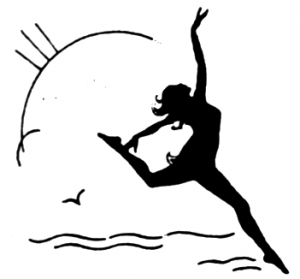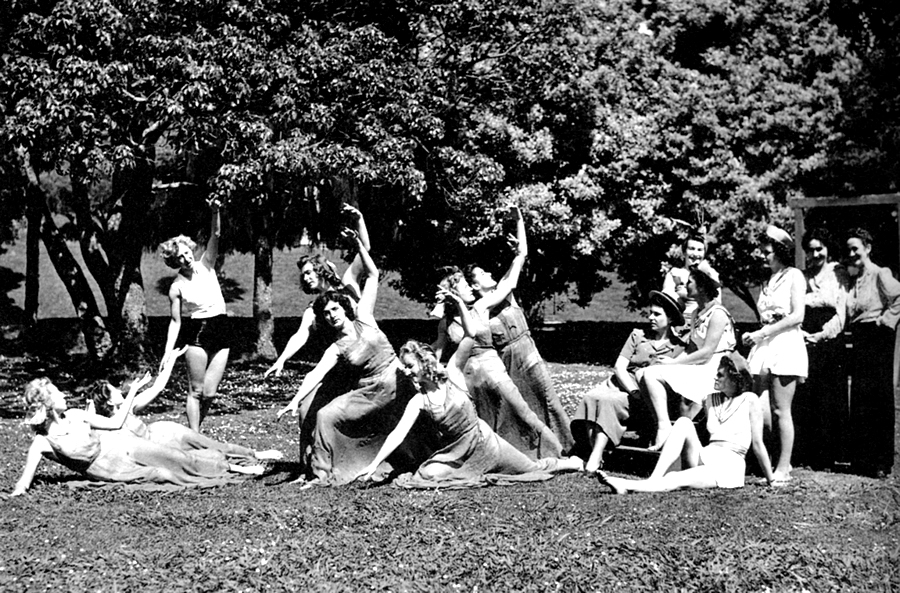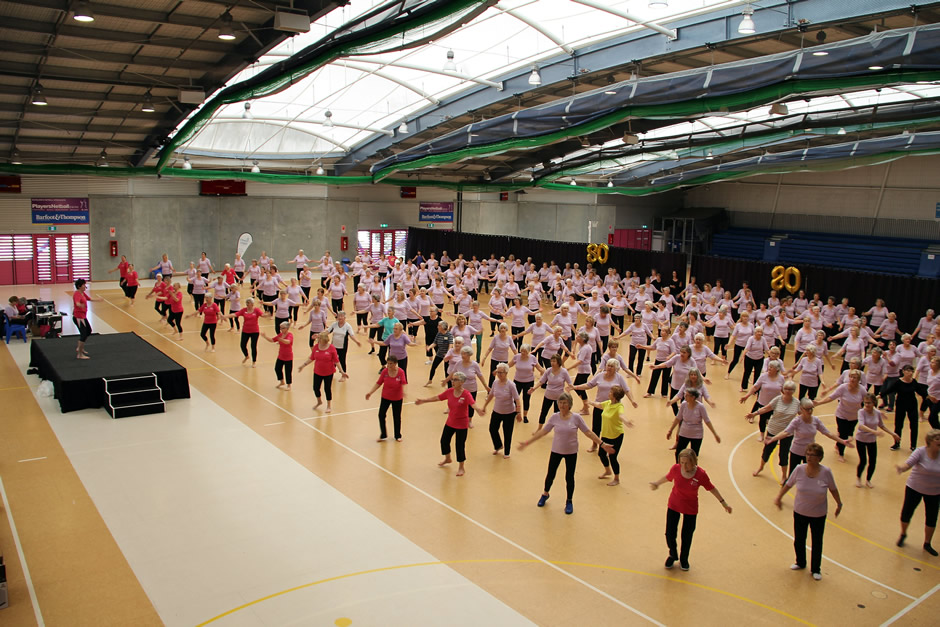
Fitness League
1937 –
Theme: Health
Known as:
- Health and Beauty Movement
1937 – c1955 - Women's League of Health and Beauty
c1955 – 2000 - Fitness League
2000 –
This essay written by Sandra Coney was first published in Women Together: a History of Women's Organisations in New Zealand in 1993. It was updated by Beryl Davy in 2018.
1937 – 1993
The Health and Beauty Movement began as a mass fitness movement for women. It arose out of changes in ideals of female beauty, and a new interest in health and fitness, in the 1930s. The Victorian and Edwardian ideal female shape was one with an ample bosom and hips, and women had relied on clothing and corsetry to achieve the desired effect. Once clothing began to become modern around World War I, so did bodies. Women's dress and bodies expressed new ideals of freedom and action, and the much scantier new clothing required a body that was slender, supple, and healthy. This was to be achieved through physical exercise.
In the early years of the twentieth century, physical fitness had been the pursuit of 'physical culturists' rather than the masses. But in the 1920s and 1930s the pursuit of health and fitness was popularised, along with a craze for sunbathing, tramping, and health foods. In this climate, the Health and Beauty Movement immediately found a market.
The movement was not indigenous to New Zealand, but was an offshoot of the Women's League of Health and Beauty, founded in Britain in 1930 by Mary Bagot Stack, who had developed an exercise system originally devised by an Australian doctor, Sir Frederick McCoy, to promote easy birth. She arranged the exercises into sequences and set them to music. Participants wore a uniform of white blouse and black satin shorts.
The Health and Beauty system presented fitness in an acceptably feminine form. 'The chief attraction of these exercises', said Millicent Ward, founder of the New Zealand movement, 'is that they are all scientific and have been approved by leading medical men of the day. Rather than muscle-building, the exercises are joint loosening, and help to promote the suppleness and poise that is so essential to the modern woman.' [1]

A N Breckton photo / Women’s Health and Beauty League
Members of the Health and Beauty Movement performing in Vansanta Gardens, Epsom, Auckland, c. 1930.
Millicent Ward trained as a teacher under Bagot Stack; she and her widowed mother decided to emigrate to New Zealand so that Millicent could found a branch of the league there. Millicent, her six daughters and youngest son arrived in Auckland in 1937, and she immediately set to work. She was a born publicist: within a short time of arriving, she and her sister Caroline featured in local newspapers and magazines. They soon had 100 members and city premises. Women joined by paying a subscription, and could also buy photographs of Millicent.
The Wards had arrived at a fortuitous time. Interest in national fitness was high, and the movement received tacit endorsement from government. Millicent and Caroline Ward visited other centres, among them Whanganui, Northland, Dunedin, and Wellington, giving dance and exercise performances and recruiting members. Part of the explanation for the movement's popularity was Millicent Ward's vibrant personality, and her knack for making women feel welcome. In each centre a branch was formed under an enthusiastic local teacher. Key leaders in the early years were Betty Page in Christchurch and Wellington, Betty Barber (later Griffin) in Whangarei, and Win Newsome in Whanganui.
The aims of the Health and Beauty Movement were to 'UNITE all women irrespective of caste, creed, race or colour in the cause of Health'; to 'TEACH scientific exercises . . . with the special object of promoting safer and easier motherhood'; and to 'IMPROVE and maintain the standard of NATIONAL HEALTH'. [2] Though only small numbers of Māori women joined, a Māori dimension was introduced via a canoe dance which Millicent Ward saw at Ngāruawāhia, and obtained Te Puea Herangi's permission to use. A small magazine for the movement, Health and Beauty News, was launched in 1939, edited by Millicent. By late 1939, 2400 New Zealand women had become members, and by 1940 over 4000 had joined. [3]
The pattern of membership followed the British one. It was largely an urban movement, making physical fitness accessible to working women – shop, factory and office workers – as well as housewives for whom there were few other recreational opportunities. One of the reasons for its popularity in New Zealand, as elsewhere, was its lack of elitism – it was a movement for all women. Although there were leaders, they were not aloof or intimidating, but participated actively in the group. 'There was no social status,' said a long-term member, 'because you found you were all in the same uniform, it didn't matter who you were.’ [4]
It was also more than just a fitness movement: members could take part in holiday camps, trips to Britain for Health and Beauty rallies, and public performances. Greek dancing was part of the movement's repertoire, reflecting its belief in the Classical Greek ideals of mental and bodily harmony.
In 1941 Millicent Ward married Dr Anthony James, an Australian, and moved to Melbourne. The loss of its charismatic leader affected the movement. Numbers were already decreasing, as many of its fit young members moved into war work, with the enthusiastic support of their leaders.
In the post-war period, the Health and Beauty Movement continued on a reduced scale and with a loyal but largely ageing membership. During these years, the New Zealand group adopted the same name as the British group, becoming the Women's League of Health and Beauty. There were problems obtaining suitable teachers: they were required to be specifically trained under the Bagot Stack method, and such training was not available in New Zealand. Three English-trained teachers arrived in the mid-1950s. From the late 1970s, the league faced stiff competition from new forms of exercise, such as jazzercise. In 1991, Millicent Ward-James was persuaded to come out of retirement to lead the league again, and in the same year a training course for teachers was at last launched. There was continuing debate about whether to make changes in the uniform and in the exercise system.
In 1987, the league celebrated its fiftieth anniversary. By 1992, there were around 800 members, concentrated in Auckland, Waikato and the Bay of Plenty.
Sandra Coney
1994 – 2018
From 1994 on, the Health and Beauty League kept up with the changes instigated by the UK League. These included changing the name to The Fitness League in 2000, and later simply to Fitness League; and promoting the system as exercise, movement and dance.
In 2018 membership was being maintained at about 700, with 16 active teachers in 29 centers from Matakana to Waikato and Bay of Plenty. Teachers began being trained in New Zealand in 1993, and could now qualify here without going to the UK, as they did formerly.
Despite the increasing age of many members and teachers, the evident benefits of the exercise system were displayed by the obvious fitness of participants well into their 80s and beyond. Medical professionals were said to frequently comment on the fitness and speedy recovery of those needing surgery. New younger members and teachers were also invigorating the organisation.
The concept of safe and effective exercise for all continued, with the findings of new research being incorporated as the system was updated; but the basics of posture in action still held true. The classes had changed from strict lines of black and white clad members to more informally arranged, colourfully clad participants, including the occasional man. Provision of the class music had shifted from pianists to cassette tapes, CDs and iPods. Various kinds of apparatus (clubs, ribbons, hoops, weights, resistance bands, scarves and canes) were being used in classes to further enhance the breadth of movement. The League’s use of websites, Facebook, and freephone numbers allowed easy contact by all.
Every five years, locally choreographed items continued to be performed by members and teachers at the London Royal Albert Hall displays, during the UK mass celebration rallies, the most recent taking place in 2015. The League also held five yearly celebrations for New Zealand members, often with visitors from the UK, Ireland and South Africa. Individual centres also celebrated significant milestones, such as Tauranga’s 40th anniversary in 2010 and Pukekohe’s 30th in 2017. Social events included fundraising fashion shows and an annual spring lunch, as well as after-class coffee gatherings in many centres.
In 2017 the Fitness League celebrated its 80th anniversary in New Zealand. Over 350 members gathered for a rally in Auckland, reflecting with satisfaction on the League’s continued existence in the face of much competition, and acknowledging the ongoing support for the organisation. The League was looking forward to the next 25 years of continued exercise, health, fun and friendship.
Beryl Davy [5]

Fitness League
Fitness League members (lilac t-shirts) and teachers (pink t-shirts) join together to celebrate the 80th celebration of the Fitness League in 2017 in Auckland.
Notes
[1] Auckland Star, 28 April 1937.
[2] 'Health and Beauty Movement: Demonstration and Rally' (booklet), 1941.
[3] Health and Beauty News, September 1939, p. 1; No. 10, 1940, p. 1.
[4] Jen Lee-Lewes, interviews with Women's League of Health and Beauty members, Auckland, 1992.
[5] This update was written with the help of Fitness League teachers.
Unpublished sources
Lee-Lewes, Jen, interviews with Millicent Ward- James, Jean Tronson, Shirley McMath, Betty Hendry, Katherine Clark, Auckland, 1992
Scrapbooks (originally in possession of Millicent Ward-James, Auckland), no longer in existence.
Published sources
Health and Beauty News, 1939-1941?
'"Health and Beauty" Classes Growing in Auckland', Auckland Star, 9 September 1950
Matthews, Jill Julius, 'Building the Body Beautiful', Australian Feminist Studies, No. 5, Summer 1987, pp. 17–34
'News from Abroad: New Zealand', Health and Beauty Exercise, No. 5, September 1991, p. 12
Sarney, Estelle, 'League Started Trend to Healthier Lifestyle', NZH, 24 February 1987
Women's League of Health and Beauty, New Zealand Golden Jubilee 1987 (booklet), WLHB, Auckland, 1987
Ward, Caroline, 'Health and Beauty', Woman To-Day, Vol. 2 No. 7, October 1938, p. 15
Ward, Millicent and Caroline, 'Health and Beauty', Mirror, March 1939, pp. 26–27; April 1939, pp. 30–31; May 1939, pp. 36–37

Community contributions